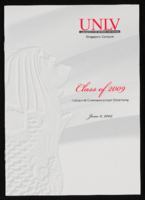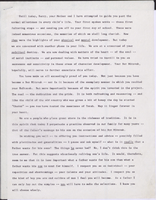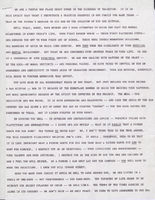Search the Special Collections and Archives Portal
Search Results
Mildred J. Heyer Photograph Collection
Identifier
Abstract
The Mildred J. Heyer Photograph Collection consists of four black-and-white photographic prints and negatives from approximately 1905 to 1940. The photographs depict early Las Vegas, Nevada street scenes, an irrigation pump, and Liberty’s Last Stand, a prominent saloon in Nevada during Prohibition.
Archival Collection
George Mortimer Photograph Album of Searchlight, Nevada
Identifier
Abstract
The George Mortimer Photograph Album of Searchlight, Nevada dates between approximately 1900 and 1910, and contains black-and-white photographic prints illustrating various scenes and individuals in Searchlight, Nevada. Some images are captioned with initials or brief names.
Archival Collection
Dayton, Nevada Gold Discovery Sesquicentennial Commemorative Plate
Identifier
Abstract
The Dayton, Nevada Gold Discovery Sesquicentennial Commemorative Plate collection (1999) contains one china plate commemorating the sesquicentennial of the discovery of gold in Dayton, Nevada in 1849.
Archival Collection
Annette Lyon Collection of Las Vegas, Nevada Casino Ashtrays
Identifier
Abstract
The Annette Lyon Collection of Las Vegas, Nevada Casino Ashtrays dates from 1965 to 1990. The collection primarily contains various glass ashtrays from Las Vegas, Nevada hotels and casinos. The collection also contains pens from various Las Vegas hotels and casinos.
Archival Collection
Felicia F. Campbell Collection on the Governor's Commission on Status of People Records
Identifier
Abstract
The Felicia F. Campbell Collection on the Governor’s Commission on Status of People Records (1970-1977) is comprised primarily of meeting minutes, agendas, reports, and memorandums from the Nevada Commission. The collection also contains women’s rights commission handbooks from various states and correspondence and newspaper clippings pertaining to Campbell's professional life.
Archival Collection

University of Nevada, Las Vegas (UNLV) Singapore Campus Class of 2009 Inaugural Commencement Ceremony program
Date
Archival Collection
Description
Commencement program from University of Nevada, Las Vegas Commencement Programs and Graduation Lists (UA-00115).
Text

Interview with Navor Tito Valdez, June 20, 2005
Date
Archival Collection
Description
Text

Transcript of interview with Charles Nur Fernald by Claytee D. White, May 31, 2014
Date
Archival Collection
Description
Text


